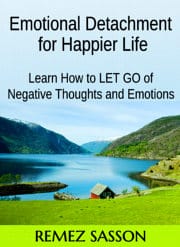
In today’s fast-paced and often chaotic world, finding moments of calm and stillness can be challenging. However, meditation offers a powerful tool to help us navigate reality with clarity and awareness.
Thich Nhat Hanh, a renowned Buddhist monk, beautifully encapsulates the essence of meditation in his quote: “Meditation is not a way of escaping reality; it’s a way to face reality.”
This statement highlights the transformative potential of meditation as a means to engage deeply with our experiences rather than turning away from them.
Browse our online courses on meditation, positive thinking, overcoming procrastination, confidence, and freedom from distractions.
In this post, we will explore the profound wisdom behind this quote. We will also insights into how meditation can assist us in embracing and understanding reality more fully.
Meditation Is not a Way of Escaping Reality
One of the common misconceptions about meditation is that it is a means of escaping or avoiding the challenges and complexities of life. However, this couldn’t be further from the truth.
Meditation is a practice that invites us to face reality head-on and engage with it in a more profound and authentic way.
By cultivating mindfulness and awareness, meditation helps us develop the ability to observe our thoughts, emotions, and sensations without judgment or aversion.
Instead of seeking to escape or suppress our experiences, we learn to fully acknowledge and accept them, even when they are difficult or uncomfortable.
This process of active engagement allows us to develop resilience, inner strength, and a deeper understanding of ourselves and the world around us.
Meditation enables us to see reality as it truly is, free from the distortions of our conditioned minds.
Through regular practice, we begin to peel away the layers of illusions, biases, and attachments that cloud our perception. We become aware of the impermanence, interconnectedness, and constant flux of reality.
By observing the rise and fall of our thoughts and emotions during meditation, we gain insights into the transient nature of our experiences and the ever-changing nature of the external world. This deeper understanding helps us navigate reality with greater wisdom, clarity, and acceptance.
Let’s now talk about what meditation can do for you, and why it is definitely a practical practice, which has nothing to do with escaping reality.
Embracing the Present Moment
Meditation is an invitation to immerse ourselves fully in the present moment. By cultivating mindfulness, we learn to direct our attention to what is happening right now, without judgment or resistance.
Instead of seeking distractions or numbing ourselves from reality, meditation encourages us to open ourselves to the rawness of our experiences.
By acknowledging and accepting our thoughts, emotions, and sensations, we develop a deeper connection with ourselves and the world around us.
Meditation is a way to help us face reality as it is, and handle it fearlessly and more efficiently.
Cultivating Awareness and Clarity
Meditation allows us to develop a heightened sense of awareness and clarity. Through regular practice, we become more attuned to the subtleties of our thoughts, feelings, and bodily sensations.
This increased self-awareness enables us to recognize our patterns of thinking and reacting, which may have previously hindered our ability to face reality.
By observing our mental and emotional states without attachment, we gain insight into the nature of our thoughts and can respond to situations with greater wisdom and compassion.
Dissolving Illusions and Attachments
Meditation helps us see through the illusions and attachments that shape our understanding of reality.
Throughout our lives, we accumulate beliefs, biases, and conditioned responses that limit our perspective.
By engaging in meditation, we create a space to examine these mental constructs and loosen our identification with them.
One of the fundamental purposes of meditation is to help us see through the illusions and attachments that cloud our perception of reality.
Often, we construct narratives and beliefs that shape our understanding of the world, leading to biases and misconceptions.
Through regular meditation, we learn to detach ourselves from these conditioned patterns of thinking and develop a more direct and unfiltered experience of reality.
By letting go of preconceived notions and fixed views, we open ourselves to a deeper understanding of the present moment as it truly is.
Cultivating Equanimity
Meditation equips us with the tools to cultivate equanimity in the face of life’s challenges. Rather than avoiding or suppressing difficult emotions or situations, we learn to meet them with an open heart and a calm mind.
By observing our inner landscape without resistance, with dis-compassion and detachment, we develop resilience and the capacity to remain grounded amidst chaos.
This attitude allows us to respond to life’s ups and downs with greater stability, grace, and compassion.
Cultivating Awareness and Clarity
Regular meditation practice cultivates a heightened sense of awareness and clarity. As we sit in meditation, we observe the flow of our thoughts, emotions, and bodily sensations without getting entangled in them.
This mindful observation allows us to become familiar with the patterns of our mind and recognize the habitual reactions that may cloud our perception of reality.
By developing this clarity, we can respond to situations more consciously rather than reacting impulsively based on ingrained conditioning.
Begin Your Meditation Journey
Thich Nhat Hanh’s insightful quote, “Meditation is not a way of escaping reality; it’s a way to face reality,” encapsulates the essence of meditation as a transformative practice.
Through meditation, we learn to embrace the present moment, cultivate awareness, dissolve illusions, cultivate equanimity, and foster interconnectedness. By engaging with
There are many meditation techniques. One that most beginners starts with involves focusing on breathing.
You will enjoy reading our collection of Thich Nhat Hanh quotes.
Focusing on Breathing
Begin your meditation practice by finding a quiet and comfortable space.
Close your eyes, take a few deep breaths, and bring your attention to the sensations of your breath as it enters and leaves your body.
Notice the rise and fall of your abdomen or the coolness and warmth of the air as you inhale and exhale.
Whenever your mind wanders, gently guide your attention back to the breath.
Watching Your Thoughts
Another most useful meditation is watching your thoughts with detachment.
During your meditation session, observe your thoughts as they arise and pass away. Notice any emotions or physical sensations that accompany these thoughts.
Instead of getting caught up in the content of your thoughts, cultivate an attitude of detachment and non-judgmental awareness.
Pay attention to the impermanence of your thoughts, emotions, and sensations. Observe how they arise, stay for a while, and eventually fade away.
By practicing detachment from your thoughts and emotions, you can develop a clearer understanding of your inner landscape, clear your mind of thoughts, and enjoy inner peace in your everyday life.
By recognizing their transient nature, you can begin to let go of attachments and fixed views that may restrict your understanding of reality.
Conclusion
Thich Nhat Hanh’s profound quote, “Meditation is not a way of escaping reality; it’s a way to face reality,” highlights the transformative potential of meditation in our lives.
Learn About Our Online Meditation Course
Various meditation techniques for finding inner peace, expanding consciousness, and awakening.
Through meditation, we learn to embrace the present moment, cultivate awareness and clarity, dissolve illusions and attachments, and cultivate equanimity.
By engaging in regular meditation practice, we develop the capacity to face reality with openness, wisdom, and compassion.
Ultimately, meditation becomes a powerful tool for living authentically and engaging fully with the beautiful and challenging aspects of our lives. It’s the road to stopping the chatter of the mind, enjoying inner peace, developing common sense, and increasing awareness.
Browse our online courses on meditation, positive thinking, overcoming procrastination, motivation, confidence, and freedom from distractions.



